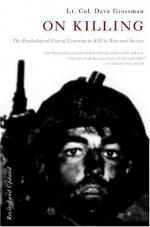
|
| Name: _________________________ | Period: ___________________ |
This test consists of 15 multiple choice questions and 5 short answer questions.
Multiple Choice Questions
1. What is the unifying element that links all of the coping tactics in Chapter 3?
(a) Enibriation.
(b) Trance.
(c) Distance.
(d) Experience.
2. At the end of Chapter 4, what physical reaction to exhaustion and hunger does Grossman cite?
(a) Involuntary urination.
(b) Organ failure.
(c) Body tremors.
(d) Ulcers.
3. In Chapter 7, Grossman says what has made killing easier for soldiers?
(a) A violent media.
(b) Training.
(c) A new enemy.
(d) Technology.
4. What do most historians agree was the key to the Roman military model's success?
(a) Strong leadership.
(b) Light, flexible armor.
(c) Political legitimacy.
(d) Longer spears.
5. In Chapter 3, Grossman says what two stimuli most often impel soldiers to kill?
(a) Fear and anger.
(b) Expectations and coercions.
(c) Psychological disorders and prejudices.
(d) Guilt and training.
6. What reason is given in Bhagavad Gita to justify killing?
(a) Killing is deliverance into heaven.
(b) All men are of the same Spirit.
(c) Soldiers must kill or be killed.
(d) Every man chooses his own death.
7. In Chapter 8, what term does Grossman use to refer to those who have killed in war?
(a) Noncriminal killers.
(b) Legalized perpetrators.
(c) Combat actives.
(d) Shooters.
8. In the final story of Chapter 4, the one in which an American and Viet Cong soldier happen upon each other, who is killed?
(a) Both men.
(b) The Viet Cong.
(c) Neither man.
(d) The American.
9. Which of the following is not an option for a soldier in combat that Grossman lists in Chapter 1?
(a) Suicide.
(b) Posture.
(c) Submit.
(d) Fight.
10. In what war did Lord Moran fight?
(a) The Rhodesian Wars.
(b) World War I.
(c) The Civil War.
(d) The Falklands War.
11. What did military analysts in World War II predict about the result of civilian bombings?
(a) Psychiatric casualties would be worse than with soldiers.
(b) Psychiatric casualties would be nonexistent.
(c) Psychiatric casualties would be equal to those with soldiers.
(d) Psychiatric casualties would be fewer than with soldiers.
12. In Chapter 4, what World War II battle does Grossman cite as an example of hunger deciding combat?
(a) Normandy.
(b) Midway.
(c) Stalingrad.
(d) Iwo Jima.
13. What does Gossman say edged weapons produce effectively at the beginning of Chapter 5?
(a) Movement.
(b) Death.
(c) Fear.
(d) Dismemberment.
14. According to Grossman in Chapter 8, what varies widely regarding those who recover from mental trauma after killing in combat?
(a) Time needed for recovery.
(b) Desire for recovery.
(c) Level of recovery.
(d) Outlet for recovery.
15. What conversion did most military personnel make to their bayonets in combat?
(a) They attached them upside down.
(b) They used the blunt end of them.
(c) They used them as hand weapons.
(d) They removed them completely.
Short Answer Questions
1. Chapter 7 begins with several vets joking about raping and murdering which public figure?
2. What great advance in military technology did Gustavus Adolphus create?
3. In the study cited by Grossman at the end of Chapter 5, what stimulus was applied to test dogs?
4. According to Grossman in Chapter 3, what is the immediate reaction to killing from a soldier?
5. According to Grossman in Chapter 2, who is often given the cold shoulder in the military?
|
This section contains 497 words (approx. 2 pages at 300 words per page) |

|




